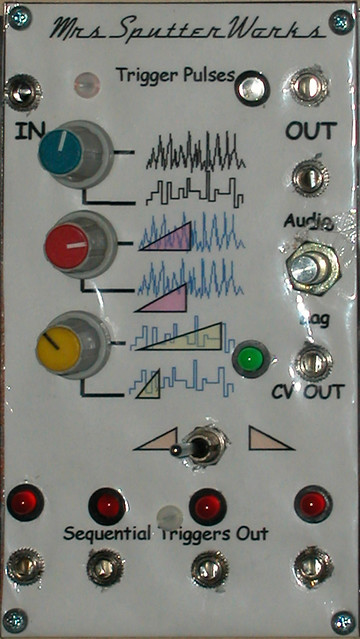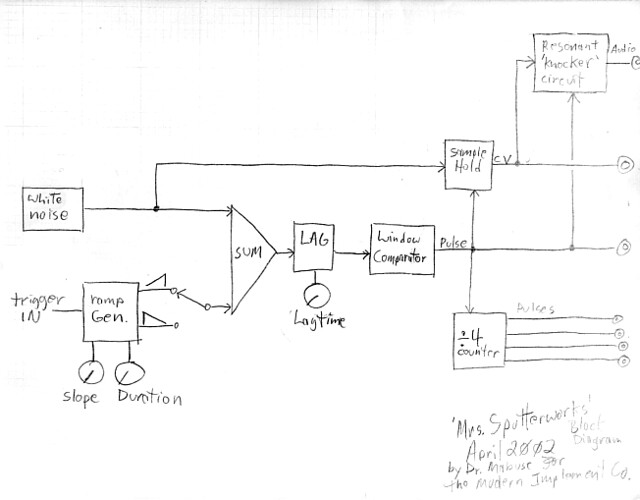Mrs. Sputterworks
The original ANALOG version
Mrs. Sputterworks is a very idiosyncratic design. It’s one of those designs that I’m fairly convinced that only I would find useful (much less worth the effort of building).
The basic functional concept is to put in a single trigger pulse and output a pattern of pulses, ‘in response’. The pattern does not repeat but the user can set parameters for overall duration, overall density, rate of change in density and ‘type of change’ (ie start dense and sputter out, or start sparse and get dense, like popcorn!). I do not want the pulses to conform to a common rhythmic grid.
The design uses ramp generators to lift a band of variable density noise toward, and then below, the threshold of a very narrow window comparator.
During the ‘construction’ phase, my faithful old benchside 2600 was not available so I rigged-up a little hi-Q resonant “knocker” circuit to give me audio feed back of the pattern of output pulses as I experimented. (this circuit is based on some experimental ideas published by the venerable Bernie Hutchins in Electronotes #111). With the addition of a degree of voltage controlled pitch, this subcircuit insinuated itself into the finished module.
The current DIGITAL Version
I have a reputation for being a very cantankerous curmudgeon about digital modules in synthesizers. This is a fair cop. I have no patience left with which to explain that the differences between audio produced by a DAC, and that produced without a DAC in the audio path, are real, discernible, and fundamental. And there have been incidents in the past during which I did NOT handle obstinate denial of this with exemplary social grace. Most of these incidents did not take place in private and word spread that it was a bad idea to bring-up ‘digital’ around doc. (sort of like saying ‘Niagra Falls‘ to the 3 Stooges) I brought that reputation on myself and have no choice but to own it.
But I’m not stupid about it. I am a software designer in my day-gig. Digital technology is the best solution (to date) for a WHOLE lot of aspects of electronic instrument design. ie: oscillators that stay, reliably & easily, in tune with a fixed pitch standard & scale, and gates & triggers that hold stable timing down to microsecond precision.
Those two examples alone are monumental reasons why digital solutions are a GOOD thing and why digital deserved to supersede analog in the applications that required those attributes. In my opinion it’s just plain silly to design a step-sequencer in this day & age using analog circuitry.
I built the original Mrs. Sputterworks to generate bursts of triggers with controllable dynamic attributes . A trigger is a simple off/on/off voltage with a fixed amplitude and a short, fixed duration. The concept is purely for CONTROL and not for audio. Let’s face it. If there was ever an application perfectly suited for a digital/software approach. This was it.
But I did it in analog first. And It worked pretty well. But as microprocessor technology got cheaper, easier, more reliable and, heck!, just plain BETTER. I realized that the idea behind Mrs. Sputterworks was actually being constrained by the analog design I applied to implement it, and that I could do it better with a very basic, reliable, $10 microprocessor. So I removed the analog circuitry from behind the panel and replaced it with a framed-out microprocessor programmed in C++. The results were unequivocally better than the original version.
In detail, (see the panel illustration above) I preserved all the core attributes of the original design; a single trigger-in creating a burst of triggers out with control over various attributes of the burst. I decided to omit the audio and stepped CV outputs because I had those features in abundance in other modules and I augmented the original feature set with a switchable self-triggering mode that ignores the trigger input and retriggers bursts cyclically with a delay set by the cycle knob, and a sync input which, when switched on, will synchronize the triggers in each burst to a pulse train in the sync input. And… of course since there IS a computer inside, I had to add a (red) reboot button in case it loses its mind at the gig.
I’m no less adamant about the value of an all-analog audio signal path. But for bursts of triggers, digital is the shit! !Viva Digital! (and you can tell ’em doc actually put that in writing!)



Comments are closed.